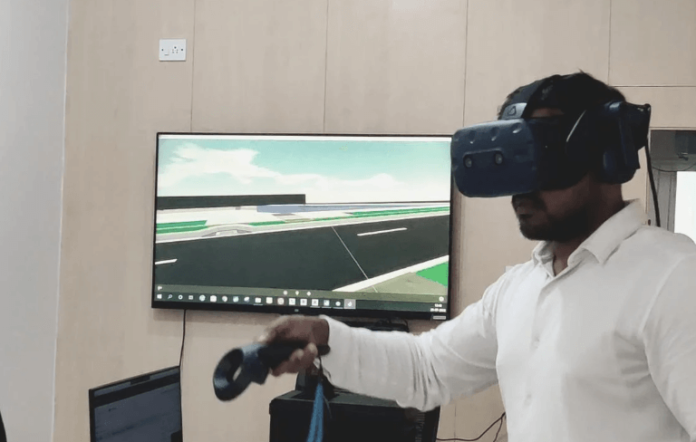Virtual Reality (VR) and Augmented Reality (AR) are making waves across various industries, and the construction sector is no exception. These technologies are reshaping the way construction professionals design, plan, and execute projects, providing innovative tools that increase efficiency, improve safety, and enhance collaboration. From visualizing building designs to facilitating on-site decision-making, VR and AR are offering unprecedented opportunities for construction companies to streamline their processes and reduce costs.
In this article, we’ll explore how VR and AR are being used in the construction industry and the key benefits they bring to construction professionals. We’ll also touch on how these technologies can be integrated with other tools, such as advanced construction estimating software, to provide a comprehensive solution for project management.
What is Virtual Reality (VR) and Augmented Reality (AR)?
- Virtual Reality (VR): VR immerses users in a completely virtual environment. By wearing VR headsets, construction professionals can experience a 3D, computer-generated world that replicates the real or proposed project. It’s a tool that offers a highly detailed and immersive experience, allowing users to explore the design of a building before construction even begins.
- Augmented Reality (AR): AR overlays digital content (such as images, models, or data) onto the real world. With AR devices, such as smart glasses or mobile devices, users can see both the physical space and the digital enhancements simultaneously. In construction, AR allows users to visualize project plans on-site and see how the project will look once completed.
See also: 4 Ways to Transition to the Next Chapter of Your Business Life
VR and AR Applications in the Construction Industry
Both VR and AR offer a wide range of applications in the construction industry, making the design, planning, and execution of projects more effective and efficient. Here are some of the most prominent uses:
1. Design Visualization and Collaboration
One of the most significant uses of VR in construction is for design visualization. By creating virtual models of a construction project, architects, designers, and clients can walk through a building or structure in 3D. This immersive experience helps identify design flaws, issues with space utilization, or aesthetic concerns before construction begins. Instead of relying on 2D blueprints or static 3D models, VR allows stakeholders to interact with the design, making it easier to understand and refine the plan.
AR also plays a vital role in design collaboration. By overlaying digital models onto physical spaces, AR allows construction professionals to see how a proposed design will look in the real world. For example, a contractor can place a virtual model of a building on the construction site and use AR to assess how it fits within the actual environment, ensuring that the design aligns with the site’s conditions.
2. Improved Project Planning and Coordination
Effective planning and coordination are critical for the successful execution of any construction project. VR and AR technologies make it easier for project teams to visualize construction timelines, resource allocation, and spatial organization in real-time. With VR, teams can walk through a virtual construction schedule, seeing how different stages of the project will unfold, and identifying potential scheduling conflicts or bottlenecks. AR can help by providing real-time data on construction progress, enabling team members to track how the project is progressing against the plan.
AR can also assist with clash detection. When a construction project involves numerous systems, such as electrical, plumbing, and HVAC, AR can overlay these systems onto physical structures. This allows construction workers and engineers to detect any clashes or issues in real-time, helping avoid costly mistakes and delays.
3. Training and Safety
Safety is one of the most important concerns in construction, where accidents and injuries are common. VR is proving to be an effective tool for training construction workers on safety procedures. By immersing trainees in simulated environments, they can practice handling hazardous situations, such as operating machinery, dealing with electrical issues, or responding to emergencies, all within a safe, controlled setting. VR training helps workers gain practical experience without the risks associated with real-life scenarios.
AR also contributes to safety by providing workers with real-time, on-site instructions. For instance, if a worker is unsure about how to complete a specific task or operate machinery, AR can display step-by-step instructions or safety precautions directly in their field of vision, guiding them through the process safely and efficiently.
4. On-Site Decision Making and Problem Solving
AR is an invaluable tool for decision-making during the construction phase. Contractors can use AR devices to overlay digital information directly onto the physical construction site. This might include structural details, material specifications, or architectural drawings. By visualizing these data points in real-time, construction professionals can make more informed decisions, spot issues early, and resolve problems without relying on paper-based documents or digital devices.
VR can also be used to simulate on-site scenarios before actual construction begins. This can help project managers and architects assess potential issues and adjust designs or construction methods accordingly. Additionally, VR models can be shared among various team members across different locations, enabling better collaboration and problem-solving.
5. Enhancing Client Engagement and Communication
VR and AR can significantly enhance client engagement and communication during the construction process. Using VR, clients can take virtual tours of the design or the ongoing project, providing them with a more tangible sense of the space. This allows for more meaningful discussions about design preferences, material choices, or adjustments. Clients can also see changes or updates in real-time, improving their overall experience and satisfaction.
AR further enhances communication by allowing clients to visualize the final project in the real world, overlaid on the actual site. Clients can use AR on their smartphones or AR glasses to see how the finished building will look once completed, which can help set realistic expectations and encourage client confidence.
Integrating VR and AR with Construction Estimating Software
The integration of VR and AR with construction estimating software can create a powerful combination for construction professionals. Construction estimating software provides detailed cost estimates for materials, labor, and resources, helping project managers develop accurate budgets. When combined with VR and AR, this software can take construction planning and decision-making to the next level.
For instance, construction professionals can use VR to visualize the project design in 3D and immediately access cost data from the estimating software. This integration helps them identify which aspects of the design may lead to cost overruns or require changes. Similarly, with AR, workers can overlay cost estimates onto physical materials or construction site features, helping them make on-the-spot decisions that align with the project budget.
Benefits of VR and AR in Construction
- Increased Efficiency: VR and AR streamline the planning and decision-making processes, reducing the time spent on revisions and rework.
- Improved Accuracy: Real-time visualization of designs and construction progress reduces errors and ensures projects stay on track.
- Enhanced Collaboration: Stakeholders, clients, and team members can collaborate more effectively by sharing immersive, interactive visuals.
- Better Safety: VR training simulations and AR safety instructions help workers stay informed and minimize the risk of accidents.
- Cost Savings: By detecting issues early, VR and AR help avoid costly mistakes, delays, and rework.
The integration of VR and AR in the construction industry is revolutionizing how projects are designed, planned, and executed. From immersive design visualizations and improved project coordination to enhanced safety and real-time decision-making, these technologies offer a wide range of benefits for construction professionals. By combining VR and AR with tools like construction estimating software, the construction industry can continue to enhance its productivity, reduce costs, and deliver better results for clients. As VR and AR technologies continue to evolve, their impact on the construction industry will only grow, creating new opportunities for innovation and success.

